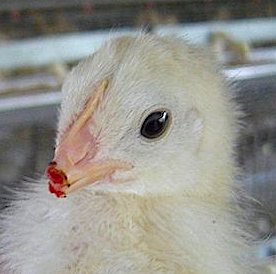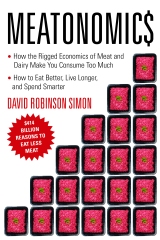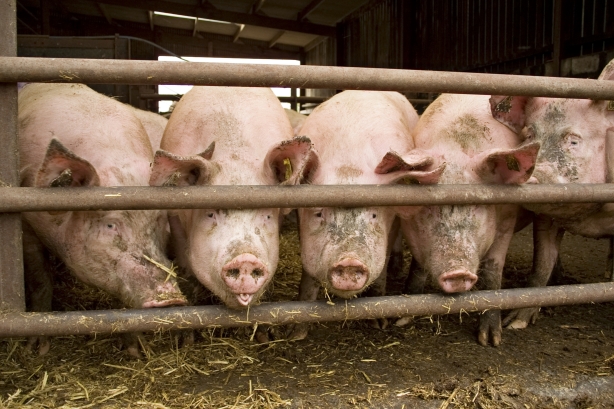 Communications from industrial animal farmers and their trade groups often lack an important element that consumers expect and the law requires: fair play. In some cases, the industry’s words are technically accurate but still unfair or misleading. In others, they’re just plain wrong. And when people rely on incorrect or deceptive information about food, the results can be downright dangerous to their health. This shady approach to salesmanship often puts meat and dairy producers in a class of their own. Honesty only makes sense, said Mark Twain, “when there’s money in it.” When it comes to promoting animal foods, it seems dishonesty pays.
Communications from industrial animal farmers and their trade groups often lack an important element that consumers expect and the law requires: fair play. In some cases, the industry’s words are technically accurate but still unfair or misleading. In others, they’re just plain wrong. And when people rely on incorrect or deceptive information about food, the results can be downright dangerous to their health. This shady approach to salesmanship often puts meat and dairy producers in a class of their own. Honesty only makes sense, said Mark Twain, “when there’s money in it.” When it comes to promoting animal foods, it seems dishonesty pays.
Remember the deadly strain of swine flu that raced across North America in the spring of 2009? When the media called the disease “swine flu,” the National Pork Producers Council angrily objected, “This flu is being called something that it isn’t, and it’s hurting our entire industry. It is not a ‘swine’ flu, and people need to stop calling it that.”[1] The pork producers got help from the USDA, with Secretary Tom Vilsack telling a worried nation, “This really isn’t swine flu. It’s H1N1 virus.”[2] But it soon turned out the “swine flu” label was completely fitting. A group of experts around the world studied the origins of the flu pandemic and published their results in the June 2009 issue of Nature. The scientists concluded that the disease started “in swine,” highlighting “the need for systematic surveillance of influenza in swine.”[3]
Sometimes the industry messaging comes in a more subtle form, or as Carl Sandburg described the stealthy movement of fog, “on little cat feet.” When several years ago I first read about a “harvesting facility” for farm animals, it took me a moment to understand what the term meant. To “harvest” is to gather crops; the word comes from the Old Norse “harfr” for harrow and the German “Herbst” for autumn. I had simply never heard it applied to animals. But of course, for those in a business that requires killing animals and selling their meat to a fickle public, “harvesting facility” and “packing house” are useful ways to describe a slaughterhouse. In fact, the violent expressions “kill,” “slaughter,” and “butcher” no longer figure in the industry’s consumer-friendly vernacular – they’ve been replaced by the kinder and gentler “cull,” “harvest,” “pack,” and “process.” Nonetheless, even industry veterans must sometimes remind one another of proper euphemistic usage. Chris Raines, Professor of Meat Science at Pennsylvania State University, writes of a colleague who was advised to chop the word “slaughter,” an “unsavory term, from a presentation to vendors of livestock feed.”[4]
 Another unsavory term you won’t hear much is “partial beak amputation,” the clinical name for chopping off one-third of an unanesthetized chick’s beak. The industry prefers the term “beak trimming,” which implies the severed portion was unnecessary or superfluous – like the wayward hairs one trims from a mustache or eyebrow. Or take “forced molting,” the practice of starving hens for up to two weeks to increase laying productivity. Causing chickens such distress that they will eat their own feathers, and sometimes killing up to one-third of the hens affected, this practice, like partial beak amputation, is routine for most laying hens in the U.S. – including those designated “cage-free.” The industry prefers the term “controlled molting,” which suggests that without the benefit of guidance, birds might just be molting all over the place. Partial tail amputation in cows and pigs, also typically performed without anesthetic, is euphemistically known as “tail docking.” Thanks to an industry striving for a kinder, gentler image, the lexicon of animal farming is rife with terms that minimize unsavory images of animals’ pain or stress and help ensure consumers don’t question or reduce their consumption of animal products.
Another unsavory term you won’t hear much is “partial beak amputation,” the clinical name for chopping off one-third of an unanesthetized chick’s beak. The industry prefers the term “beak trimming,” which implies the severed portion was unnecessary or superfluous – like the wayward hairs one trims from a mustache or eyebrow. Or take “forced molting,” the practice of starving hens for up to two weeks to increase laying productivity. Causing chickens such distress that they will eat their own feathers, and sometimes killing up to one-third of the hens affected, this practice, like partial beak amputation, is routine for most laying hens in the U.S. – including those designated “cage-free.” The industry prefers the term “controlled molting,” which suggests that without the benefit of guidance, birds might just be molting all over the place. Partial tail amputation in cows and pigs, also typically performed without anesthetic, is euphemistically known as “tail docking.” Thanks to an industry striving for a kinder, gentler image, the lexicon of animal farming is rife with terms that minimize unsavory images of animals’ pain or stress and help ensure consumers don’t question or reduce their consumption of animal products.
[1] Chris Welch, “Inaccurate ‘Swine’ Flu Label Hurts Industry, Pork Producers Say,” CNN Health (April 30, 2009), accessed April 19, 2012, http://articles.cnn.com.
[2] Caitlin Taylor, “Obama Administration: Out with the ‘Swine,’ In with the ‘H1N1 Virus,’” ABC News Political Punch (April 29, 2009), accessed September 15, 2011, http://abcnews.go.com.
[3] Gavin J. D. Smith et al., “Origins and Evolutionary Genomics of the 2009 Swine-Origin H1N1 Influenza A Epidemic,” Nature 459 (2009): 1122–25.
[4] Chris Raines, “Slaughter, Harvest, and Implications of the New Diction” (blog) (July 19, 2011), accessed September 15, 2011 at http://meatblogger.org/2011/07/19/slaughter-harvest-and-implications-of-the-new-diction.


Reblogged this on XCLUSIVX DIY fanzine: Hardcore. Veganism. Politics..
. . . And don’t forget — “MEAT” is now “protein”, so this blog will be changing its name to conform to BigAG corporate communications protocols and is being relaunched as “PROTEINONOMIC$” just in case anyone might possibly get a negative opinion about burgers or anything which might dissuade the sale of a single Big Mac or Whopper thus setting off a chain of events where Dave would then be prosecuted in Texas or somewhere just like Oprah.
My general policy is not to visit Texas just in case the meat industry is waiting to serve me with process.
Glad you mentioned that sly transformation and disappearance of the word meat. I’ve noticed it especially in cooking programs, where within the last decade all the chefs, judges, and contestants everywhere started substituting the word “protein,” as if some global switch had been thrown. It’s become entrenched, and new generations are growing up hearing it and unthinkingly assimilating its use. To watch this unfold adds to one’s realization of how much of culture has been invented and manipulated by marketers.
This is a brilliant article. We are struggling in South Africa with retailers lack of integrity and honesty.
grassconsumeraction.wordpress.com
Reblogged this on Grass Consumer Group and commented:
How Consumers are kept in the dark about their food